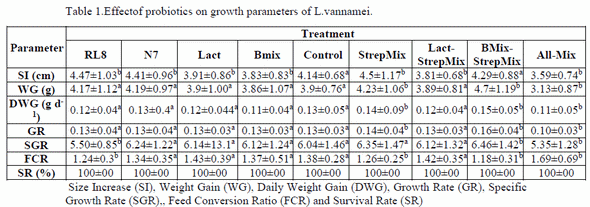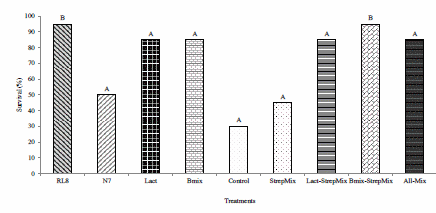Introduction
Aquaculture is the fastest growing sector of food production, comprising almost 50 % of fish aimed at human consumption worldwide. It is estimated that aquaculture production should be two and a half order of magnitude by 2030 to keep up current levels of per capita consumption. Aquatic animals such as finfish, crustaceans and molluscs are particularly susceptible to a broad range of bacterial pathogens, which include members of the genus Aeromonas, Vibrio and Pseudomonas. These microorganisms, which are part of water microflora, may however become pathogenic under stressful conditions, poor water quality or physiological impairment of aquatic animals (Balcazar et al., 2006). Chemotherapeutic agents have traditionally been used to control unwanted bacterial populations. Nonetheless, this practice has stimulated the rising of bacterial resistance and uncontrollable infectious diseases (Rodgers and Furones, 2009). In this context, benefic microorganisms or probiotics have emerged as efficient agents to control infectious diseases through mechanisms of competitive exclusion. Probiotics given in larval and juvenile stages reduce mortality rates and increase growth (Nimrat et al., 2011).They are usually applied with food or in the water, (Verschuere et al., 2000). Many bioactive compounds including antimicrobial, antitumoral and immunosuppressant agents as well as different enzymes have been discovered from sea microorganisms, mainly Actinomycetes (Tanaka and Omura, 1990). Among them, the genus Streptomyces has been regarded as an excellent producer of antibiotics (Ellaiah and Reddy, 1987). However, this genus has been considered as probiotic agent for aquaculture in very few studies (Das et al., 2006). The aim of this study was to investigate the effect of Streptomyces strains N7 and RL8 alone or in combination with other probiotics over the growth and survival of the white shrimp Litopenaeusvannamei after challenge with Vibrio parahaemolyticus.
Materials and Methods
Organisms and Maintenance
Healthy juveniles of the white shrimp Litopenaeusvannamei with average weight of 0.78±0.03g were purchased from AcuaculturaMahr S.A. Company, La Paz, B.C.S. Animals were kept in glass fiber tanks of 1500 L containing sea water filtered through a one-μm mesh and sterilized under UV light. Water was kept at 29±1 °C, 37 PSU of salinity and with constant aeration throughout the experiment. Shrimps were fed ad libitum three times daily with a commercial diet (PIASA, 35% of protein).
Probiotic and Pathogenic strains
The probiotic strains used in this study were Streptomyces strains RL8 and N7, isolated from marine sediment and selected in previous in vitro studies (García-Bernal et al., 2015); a Bacillus mixture (BMix (Luis-Villaseñor et al., 2011); and a Lactobacillus Except the Lactobacillus strain that was grown in Man-Rogosa-Sharpe (MRS) medium, all other strains were cultured in tryptone soy broth (TSB) containing 3% sodium chloride. Streptomyces strains were cultured under shaking conditions at 30°C during 7 days whereas Bacillus and Lactobacillus were incubated at 35°C for 24-48 hours. Cultures were subsequently centrifuged at 4696 g and 4°C for 10 minutes and the resultant pellet was washed twice with sterile sea water. The final pellet was resuspended in sterile sea water to an optical density of 1 at 600 nm for Actinomycetes and 540 nm for BMix and Lactobacillus; equivalent to 1 x 109 CFU mL-1 broth (TSB) containing The pathogenic Vibrio parahaemolyticus CAIM 170 was cultured in tryptone soy broth that 35 °C for 24-48 hours. Culture was centrifuged at 4696 g and 4 °C for 10 minutes and the resultant pellet was resuspended in 3% (w/v) saline solution to an optical density of 1, equivalent to 1 x 109 CFU mL-1.
Probiotic preparation
Probiotic suspensions were added to food by aspersion to a final concentration of 1×108 CFU g-1 of food for Streptomyces and 1×106 CFU g-1 for Lactobacillus and BMix. Control diet received an equivalent amount of sterile sea water. Food was dried at room temperature for 24 hours after adding suspensions and then stored at 4°C. Food supplementation with probiotics was performed on a weekly basis.
Probiotic Treatment
Shrimps were randomly distributed into 120-l tanks of glass fiber (50 shrimps/tank) containing filtered (5μm) sterilized sea water, at 29±1°C and constant aeration. Nine experimental groups with two replicas each were set as follow: (RL8) Streptomyces strain RL8; (N7) Streptomyces strain N7; (StrepMix) Streptomyces mixture (i.e. N7+RL8); (Lact) Lactobacillus; (Lact- StrepMix) Lactobac illus+Streptomycesmixture;(BMix) Bacillus mixture; (BMix-StrepMix) BMix+Streptomyces mixture;(All-Mix) all-probiotics mixture; and Control (no probiotic added). At the end of treatment (30 days), the Size Increase (SI), Weight Gain (WG), Daily Weight Gain (DWG), Growth Rate (GR), Specific Growth Rate (SGR), Absolute Growth Rate (AGR), Feed Conversion Ratio (FCR) and Survival Rate (SR) of different treatments were calculated according to previously described methods (Felix and Sudharsan, 2004)
Challenge with Vibrio parahaemolyticus CAIM 170
Challenge was performed by the immersion method using a V. parahemolyticus CAIM 170 suspension of 1 x 106 CFU mL-1(Austin et al., 1995), after applying probiotics for 30 days. All nine groups having ten animals and two replicas each were challenged. Organism survival was daily recorded during four days.
Statistical Analysis
Normality and variance homogeneity were initially assessed by the Kolmogorov–Smirnoff and Levene tests, respectively (Sokal and Rohlf, 1981). Data were analyzed using ANOVA followed by the Tukey post-hoc comparison to identify differences in the growth Analysis was performed using Statistica 6.0 software (StatSoft, Tulsa, OK). Statistical significance was set at p<0.05. The survival percentage was calculated for each experimental group and compared with the positive control to determine survival significance level through Pearson Chi-square and the Fisher Exact Test, using the SPSS program version 21.0.
Results and Discussion
Effect of probiotics on shrimp growth
Several growth parameters were determined after feeding the white shrimp L. vannamei with different probiotic diets (Table 1). In general, non-combined Streptomyces groups (strains N7 and RL8) exhibited better growth parameters than probiotic control groups (Lact and BMix) and the non-treated control, although these differences were only significant for the SI as well as for SGR and FCR of Streptomyces RL8 (Table 1, p<0.05). For Streptomyces combinations, the StrepMix and the BMix-StrepMix groups showed significantly better growth parameters than the Lact- StrepMix, the All-Mix as well as the non-treated control group (Table 1, p<0.05).There was no mortality associated to any probiotic treatment during the 30-days feeding experiment. Probiotics has become a sustainable paradigm to replace the use of chemical compounds and antibiotics in aquaculture (Bidhan et al., 2014).
The growth improvement we have found through the application of Streptomyces strains N7 and RL8 is consistent with previous works, which showed growth increase of the ornamental fish Xiphophorushelleri and the black tiger shrimp Penaeus monodon after the application of Streptomyces to food (Das et al., 2010; Dharmaraj and Dhevendaran, 2010). Previous studies have also shown that the addition of probiotics to food or water improves growth performance of L.vannamei (Liu et al., 2009), which is thought to be due to the production of extracellular enzymes such as proteases, carbohydrolases and lipases as well as growth factors that participate in the digestion processes of shrimps (Liu et al., 2009). Actinomycetes are also able of producing a repertoire of different extracellular enzymes that decompose organic matter such as starch, cellulose, proteins and lipids (Prakash et al., 2013). As we have previously shown, Streptomyces strains N7 and RL8 produce some of these enzymes (García-Bernal et al., 2015). Thus, it is probable that they may have played a role in the growth improvement we have found in this study.

Data are expressed as mean ± standard deviation. Treatments with different letters differed significantly from control (p<0.05).
Survival rate after V. parahaemolyticus challenge
All experimental groups were challenged with V. parahaemolyticus CAIM 170 after feeding animals with different probiotic strains during 30 days, except for the positive control group. After recording survival during 96 hours, all probiotic-fed groups exhibited a higher survival rate than the control group. The Streptomyces RL8 and BMix-StrepMix groups, with a survival rate close to 95%, exhibited a significantly higher survival rate than the control group(p<0.05, Figure 1). Even though the Lact, Lact-StrepMix, Bmix and All-Mix groups showed a high survival rate, which was close to 85%, it wasn’t significantly higher than the control group(p?0.05, Figure 2).
Only the Streptomyces N7 and StrepMix groups showed the lowest survival rate of all probioticfed groups.
Fig 1. Survival of juveniles of Litopenaeusvannamei fed with different probiotics after challenge with V. parahemolyticus. Bars with different letters differed significantly from control (p<0.05).
This is in agreement with previous findings of Das et al. who showed that Streptomyces strains CLS-28 significantly increased the survival rate of Penaeus monodon after challenge with Vibrio harveyi (Das et al., 2010). Although these authors attributed this protective effect to the wellknown capacity of marine Streptomyces to produce antibacterial compounds (Das et al., 2010).
Conclusions
This study shows that some Streptomyces strains alone or combined with other genera, primarily Bacillus, may exert a probiotic effect on shrimps by improving growth parameters and increasing resistance to disease. Among the two Streptomyces strains as well as their combination with Bacillus and Lactobacillus, the Streptomyces strain RL8 and BMix-StrepMix are the most promising probiotic candidates to be used in shrimp aquaculture. This combination of Streptomyces with Bacillus deserves further attention as they are spore-forming bacteria that may produce a multitude of extracellular enzymes and antibiotics (Chater et al., 2010; Hong and Cutting, 2005), which may be developed into novel control agents with improved probiotic features and extended shelf life.
References
Austin, B., Stuckey, L., Robertson, P., Effendi, I., Griffith, D., 1995. A probiotic strain of Vibrio alginolyticus effective in reducing diseases caused by Aeromonassalmonicida,Vibrioanguillarum and Vibrio ordalii. Journal of fish diseases18, 93- 96.
Balcazar, J.L., de Blas, I., Ruiz-Zarzuela, I., Cunningham, D., Vendrell, D., Muzquiz, J.L., 2006.The role of probiotics in aquaculture.Veterinary microbiology114, 173-186.
Bidhan, C.D., Meena, D.K., Behera, B.K., Das, P., Das Mohapatra, P.K., Sharma, A.P., 2014. Probiotics in fish and shellfish culture: immunomodulatory and ecophysiological responses. Fish Physiol Biochem40, 921-971.
Das, S., Lyla, P., Ajmal Khan, S., 2006. Application of Streptomyces as a probiotic in the laboratory culture of Penaeus monodon (Fabricius). The Israeli Journal of Aquaculture – Bamidgeh58, 198-204.
Das, S., Ward, L.R., Burke, C., 2010. Screening of marine Streptomyces spp. for potential use as probiotics in aquaculture. Aquaculture305, 32-41.
Dharmaraj, S., Dhevendaran, K., 2010. Evaluation of Streptomyces as a probiotic feed for the growth of ornamental fish Xiphophorushelleri. Food Technology and Biotechnology48, 497- 504.
Ellaiah, P., Reddy, A., 1987. Isolation of actinomycetes from marine sediments off Visakhapatnam, east-coast of India. Indian Journal of Marine Sciences16, 134-135.
Felix, N., Sudharsan, M., 2004.Effect of glycine betaine, a feed attractant affecting growth and feed conversion of juvenile freshwater prawn Macrobrachiumrosenbergii.Aquaculture Nutrition10, 193-197.
García-Bernal, M., Campa-Córdova, A.I., Saucedo, P.E., Casanova-González, M., Medina- Marrero, R., Mazón-Suástegui, J.M., 2015. Isolation and in vitro selection of actinomycetes strains as potential probiotics for aquaculture. Veterinary World8, 170-176.
Liu, C.H., Chiu, C.S., Ho, P.L., Wang, S.W., 2009. Improvement in the growth performance of white shrimp, Litopenaeusvannamei, by a protease-producing probiotic, Bacillus subtilis E20, from natto.Journal of applied microbiology107, 1031-1041.
Luis-Villaseñor, I.E., Macías-Rodríguez, M.E., Gómez-Gil, B., Ascencio-Valle, F., Campa- Córdova, Á.I., 2011. Beneficial effects of four Bacillus strains on the larval cultivation of Litopenaeusvannamei. Aquaculture321, 136-144.
Nimrat, S., Boonthai, T., Vuthiphandchai, V., 2011.Effects of probiotic forms, compositions of and mode of probiotic administration on rearing of Pacific white shrimp (Litopenaeusvannamei) larvae and postlarvae. Animal Feed Science and Technology169, 244-258.
Prakash, D., Nawani, N., Prakash, M., Bodas, M., Mandal, A., Khetmalas, M., Kapadnis, B., 2013.Actinomycetes: a repertory of green catalysts with a potential revenue resource. BioMed research international2013, 264020.
Rodgers, C., Furones, M., 2009. Antimicrobial agents in aquaculture: Practice, needs and issues. Options Méditerranéennes86, 41-59.
Sokal, R.R., Rohlf, F., 1981.Biometry (2nd edn). New York: WH Feeman and Company668. Tanaka, Y., Omura, S., 1990.Metabolism and products of actinomycetes.Anintroduction. Actinomycetol4, 13-14.
Verschuere, L., Rombaut, G., Sorgeloos, P., Verstraete, W., 2000. Probiotic bacteria as biological control agents in aquaculture.Microbiology and molecular biologyreviews : MMBR64, 655- 671.









.jpg&w=3840&q=75)